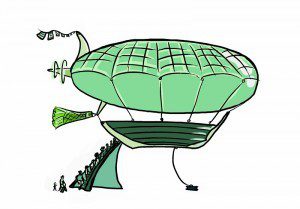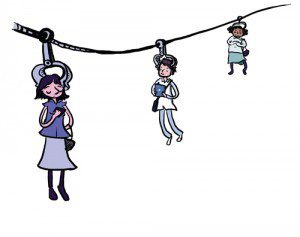Emmanuel Francalanza imagines how Malta’s transport system might look in 2025. Illustrations by Sonya Hallett
I’m writing this article at 30,000 feet as I am flying back home. At a mere 316 km2, Malta is one of the smallest countries in the world and everywhere is ‘close’. But it still takes a long time to reach work. Reaching University is only the start of the problem, that’s when the parking nightmares begin. These issues apply to everyone, not just University academics. Don’t we all wish that we could call out ‘beam me up Scotty’ and be teleported to our destinations, especially if you’re caught in a traffic jam in Marsa on the way to catch a flight?
Traffic and parking issues are not our only problems. Being an island nation causes major logistical headaches for construction, retailing, and manufacturing companies. Sustaining Maltese companies and attracting foreign investment is a challenge. Let alone for Gozo.
As I sit here thinking, I ask myself the question: What can transportation in Malta look like in 2025? But as an engineer I know that I must first ask myself: what will Malta’s transportation requirements be in 17 years time? How will cars change? How can ships be more efficient? And, how can we make planes safer?

Cars of Tomorrow
In the close future we will be seeing smaller, greener vehicles. Many car manufacturers are downsizing engines — nothing new. Cars like the Beetle, Cinquecento, and Mini have always been around encouraging smaller, more economical vehicles. Today, a different approach is coming into play. Engine downsizing is being managed by introducing turbocharging. Turbocharging works by forcing air and increasing the pressure in the engine’s combustion chamber. By doing so the energy is released when the fuel is ignited, pumping more power. Increased energy leads to a greater torque to turn the car’s wheels. Having a turbocharged engine means that you can still achieve a higher brake horse power (bhp) for a smaller engine. A smaller engine uses less fuel and pins the car to a less expensive license. Consumers gain cheaper running costs at lower emissions helping out the environment.
Turbocharging has been around since 1885, used to power fighter plane engines in WWII and supercharge Formula 1 cars. In cars it was first used to increase the power for smaller diesel engines. Now, it is being used to turbocharge small petrol engines.
“In the late 90s it used to take 48 months for a vehicle to make it from the drawing board to our garages. In 2013, it takes 18 months”
Turbocharging sounds powerful, but it does add some problems. Turbocharging places a compressor at the air inlet of an engine. The turbocharger increases the air pressure and temperature. Hotter gases can cause the fuel-air mixture in the compression chamber to ignite before the peak of the combustion cycle. When this happens the car engine knocks. Knocking can be avoided by cooling the charged air with a bulky inter-cooler which cools the compressed air before being forced into the combustion chamber. Knock is elusive to study since it is irregular making mathematical and physical modelling tricky.
Dr Ing. Mario Farrugia is trying to model knock and get the timing right. He is testing turbochargers on motor bikes and a standard Ford engine. Pressure measurements in the combustion cylinder are taken to try and better understand the conditions where knocking is caused. By preventing knock, turbocharged engines will continue entering the mass automotive market and become more common.
3D everything
 The time it takes to design a car, from concept to our roads, has plummeted over the past decades. In the late 90s it used to take 48 months for a vehicle to make it from the drawing board to our garages. In 2013, it takes 18 months. By decreasing product development time, companies are under added pressure to quickly translate ideas into cars. Companies use 3D CAD (Computer Aided Design) programs to build car models. However, 2D sketches are faster and more intuitive than 3D models. Sketching communicates ideas to others. One might, for example, sketch a map to explain to someone how to get to a place. An architect will sketch the plan of a building to illustrate his design ideas. An engineer might sketch circuit diagrams, models of 3D prototypes, or machine parts. A picture can say a thousand words.
The time it takes to design a car, from concept to our roads, has plummeted over the past decades. In the late 90s it used to take 48 months for a vehicle to make it from the drawing board to our garages. In 2013, it takes 18 months. By decreasing product development time, companies are under added pressure to quickly translate ideas into cars. Companies use 3D CAD (Computer Aided Design) programs to build car models. However, 2D sketches are faster and more intuitive than 3D models. Sketching communicates ideas to others. One might, for example, sketch a map to explain to someone how to get to a place. An architect will sketch the plan of a building to illustrate his design ideas. An engineer might sketch circuit diagrams, models of 3D prototypes, or machine parts. A picture can say a thousand words.
Humans easily interpret sketches. Machines don’t have it so easy. Industrial designers need their sketches quickly turned into 3D models. A local team is developing software that turns a sketch into a 3D model.
First they developed a sketching language, with certain symbols giving commands to the programme. Then they created a programme that could interpret the objects drawn. The researchers could sketch a new kettle or make-up case and it turned into a 3D image ready to be popped into a CAD programme for further development and refinement.
The number of drawings the programme can interpret is limited, so Alexandra Bonnici is developing a more advanced version. She plans to let designers draw normal shaded drawings, which means that the programme needs to do more legwork. It uses a much more sophisticated algorithm to interpret shadowing, curves, and other cues in the sketch. Designers might soon be able to draw whatever they want, send the information to a computer, and out comes a 3D model they can turn into reality. Cars (and other products) might start popping out of factories much faster.
Factories of the Future
Future factories look nothing like the dirty, smelly, and menacing environments we normally associate with manufacturing. Future factories will provide clean, safe, and highly automated environments. Most car companies use vast automations in their assembly lines. Computer controlled robots cut, slice, piece together, and weld, with a few engineers playing puppet master.
To be competitive, the local manufacturing industry needs to go down the same line. Prof. Ing. Michael Saliba has led a research team that surveyed automation use in Maltese companies. Local manufacturers face particular problems automating their factory. Our geographic isolation combined with a general shortage of local suppliers and expertise. Perceptions seem to link automation with expensive big foreign manufacturers but this research found that recent automation approaches could be very beneficial. They allow a plug and play approach to manufacturing. Different modules can be added or removed to a production line depending on the manufacturing requirements. Its versatility is its attraction.
Boats: sleeker, stronger, smarter
As summer sets in we all look forward to spending more time at the beach, enjoying water sports, or just cruising around Malta. As a group of islands, boats are part of our culture. But how will they look, drive, and feel in 2025? What will they be made up of?
Most of our boats right now are made of fiberglass. Fiberglass is a composite material made up of two components: an epoxy resin that bulks the material and glass fibres that reinforce everything. Boats are produced by layering several layers of fiberglass sheets. Polyester resin is then added manually using a brush or roller. The resin combined with the fiberglass is called a single skin laminate. Later, wood reinforcements are added to stiffen the hull, which makes everything much heavier.
A more advanced technique of manufacturing fibreglass structures uses sandwich construction. Sandwich construction is widely used for wind turbine blades and in the aerospace industry, but locally it has not been adapted to make boats. Marine engineer Dr Claire De Marco is leading a project to introduce these advanced fibreglass manufacturing techniques to the local boat building industry. By 2025 this research will help make boats in Malta lighter saving fuel and reducing costs.
De Marco’s project will also make boats stronger. By making use of a new process for fabricating fiberglass laminates called ‘vacuum bagging’ the final structure will have more fibres in it, strengthening it. Vacuum bagging works by sucking out the air when the resin is being applied, creating a thinner, more even layer. The reduction in resin content reduces thickness making the material less stiff. To withstand the high forces that boats find in rough seas, a lightweight foam core is added between the two thin skins of fiberglass.
This project will help boat designers to easily choose the appropriate fiberglass sandwich laminate for a boat design. These laminates produce boats which are lighter and stronger than today’s single-skinned boats. Combine this with vacuum bagging manufacturing and we will have stronger, lighter, longer-lasting boats, definitely by 2025.
Not falling to pieces
While at 30,000 feet above the ground, it dawned on me that we must all have some fear of flying. After all, we didn’t evolve to fly, let alone in a thin, long cylinder. Spectacular airplane crashes in the news do not help. Engineers need to keep airplanes safe. How much safer can they be by 2025?
Ground collisions cause injury and are costly for companies. Research shows that aircraft taxiing is the second most common cause of accidents. Bad weather and unfamiliarity with airports normally lead to these accidents. Automatic taxiing could help prevent these accidents.
“With these advances, by 2025 gone might be those missed holiday celebrations due to bad weather”

A new cockpit design that will help airplanes taxi on the ground is being developed in part by the Department of Electronic Systems Engineering. Sensors communicate to an airplane’s cockpit and raise an alarm if a crash might happen. The system tells the pilot to stop or continue and where to turn. With this system pilots can quickly respond to possible collisions. At the University of Malta, the concept was first tested in a mock-up simulator. The system was also tested all over Europe. Airplanes’ systems cannot really fail after all. Commercial airlines were also involved in assessing the performance and value of the cockpit. The system passed with flying colours.
Snow, thunderstorms, and other extreme weather can ground an airplane. Another project, ALICIA, is trying to develop new cockpit applications that would help pilots operate under any weather conditions. Preventing flight cancellations or delays would save millions and keep many customers happy.
‘Simple is better’ is the design concept behind this new cockpit. Complex solutions would only distract the flight crew. Too much information is overwhelming. The cockpit streamlines the workload helping to interpret some of the data gathered by the plane. Faster responses to emergencies help prevent catastrophe.
New systems are also being developed to help guide pilots while taxiing. Instead of raising alarms, synthethic vision is being developed. Synthetic vision uses inputs from on-board sensors to provide a location on a 3D map (similar to Google Maps) of the surroundings. Hangars, terminal building, control towers are all in crisp 3D guiding the pilot. The system can also be overlaid with other layers of info. Air traffic signals, pressure, temperature can all be added as needed, letting the pilots modify the system to their needs.
With these advances, by 2025 gone might be those missed holiday celebrations due to bad weather. Pilots might also have better planes that alert them to collisions and use 3D maps to guide them around airports.
Touching the future
The future will see captains and flight crew interacting with their airplane commands in a way we would have not imagined up to a decade ago. Touchscreen cockpits are being developed that would show a single display, instead of the myriad controllers we see today. On this screen the pilot could see altitude, direction, destination, and interact with it by a swipe of the hand. A team of local researchers led by Prof. Ing. David Zammit-Mangion is working on this next step in airplane control by participating in a number of research projects funded by both national and EU funds.
The project Touch Flight might change how commercial airplane pilots interact with their aircraft. Currently pilots input data, and programme flight management and guidance systems through a keyboard and buttons, while using knobs to set speed, altitude and navigation. This could change by applying touch-screen technologies. In cars the technology made car satellite navigation systems much more intuitive and convenient to use. The same could soon be coming to planes.
“Touch screen cockpits would revolutionise aircraft displays representing the future in cockpit displays”
Zammit-Mangion is finding solutions to display all of this information on a touch screen display. He is focusing on mission management and flight navigation information. Touch screen cockpits would revolutionise aircraft displays representing the future in cockpit displays.
The upgrade will not come easily. Major challenges exist since airplanes fly under stringent safety requirements and harsh operational conditions. The pilot needs to be able to input data correctly on the touch screen in turbulent, stressful, and emergency conditions. Dreaded blue screens and system crashes cannot happen mid-flight. While revolutionary the system could take longer than 2025 to see it in most planes.
Single cockpit displays are another concept the Department is working on as part of a big European project. New projection technologies employing multiple projectors can project a seamless image over a wide area. Touch-sensitive technologies were coupled to the projectors to allow touch inputs on this single screen. The concept was developed and tested on different simulators. Common cockpit uses (primary flight display, navigation display and others) were developed for the screen making the first ever single, end-to-end interactive cockpit. The mock-up has already attracted strong interest from industrial stakeholders, which means that we might see this technology by 2025.
 Maltese Transport 2025
Maltese Transport 2025
2025 is just 12 years away; can research change Malta so quickly? The potential is huge. Our engineers could make boats which are faster, lighter, and harder to sink. From the outside the boats would not look very different, but the way they are made would be radically improved. The problem of making boats powered by renewable energy is still up for grabs.
Cars would also get an upgrade. Car engines would be smaller and more powerful. They would use less fuel, be more environmentally friendly and relatively cheaper to run. Unfortunately, this doesn’t solve the problem of having one of the highest car densities in the world, which clogs our roads every day.
By 2025 planes could guide the pilot to avoid mistakes. The cockpit would be radically redesigned and if you manage to land a jump seat your experience would be revolutionised. Planes have other problems and questions to overcome. Will they be smaller or bigger to increase efficiency and reduce the burden on our planet? Will they become personal and enter Blade Runner’s world of flying cars? Will we take humans out of the equation to make them safer? In the hands of engineers, the future will surely be an interesting place to live in.


 Maltese Transport 2025
Maltese Transport 2025


Comments are closed for this article!